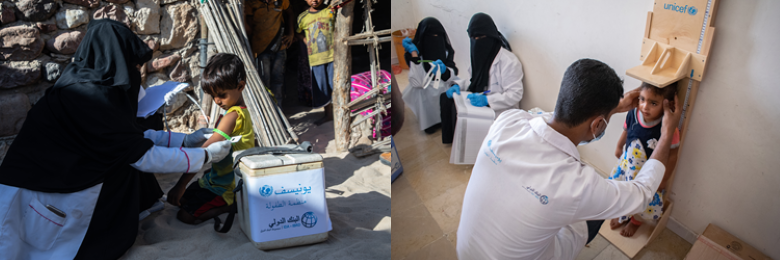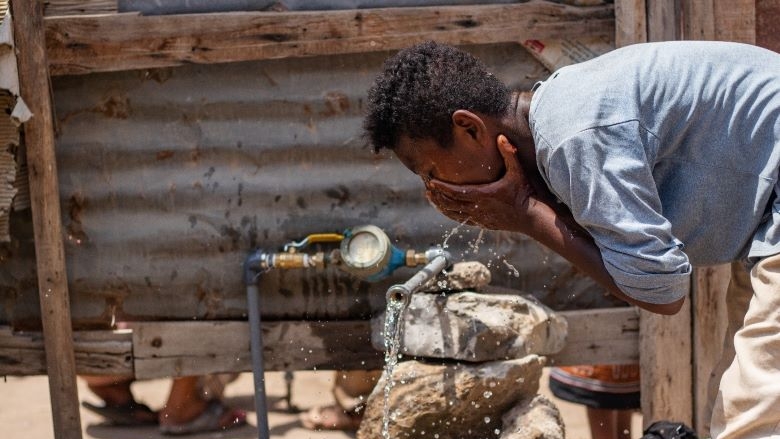Synopsis
Just over four years ago, as Yemenis struggled with the effects of armed conflict on their lives, the World Bank, UNICEF, and World Health Organization (WHO) joined forces with Yemen’s Ministry of Public Health and Population and health offices in regional governorates as well as local water and sanitation corporations at decentralized level to maintain the delivery of essential health, water and sanitation services. The Emergency Health and Nutrition Project (EHNP) had a twofold mission: to strengthen public health and nutrition services and to improve water and sanitation systems. More than 26 million Yemenis were provided with life-saving services, including primary health care delivered through clinics and mobile health teams.
Challenge
The conflict in Yemen had greatly disrupted the delivery of health, water and sanitation services and the efforts of healthcare workers and water and sanitation institutions to provide critical support to families for child nutrition and health, water and sanitation services, information, and education on both, and the water-delivery and sanitation systems on which public health facilities and school depend.
Hospitals and other healthcare facilities and water and sanitation infrastructure have been especially hard-hit since the start of the conflict in March 2015. Only half the healthcare facilities that were operating in 2014 are operational today. Even those still open face challenges, such as lack of clean water, fuel for generators, or medical supplies. With more than two million children severely malnourished and nearly 80 percent of Yemenis depending on aid, insufficient potable water has led to severe outbreaks of cholera and diphtheria.
Approach
The Emergency Health and Nutrition Project (EHNP) sought to improve the health of communities by directing funds to medical facilities, supporting staff by giving them allowances, and directly underwriting the cost of outreach and mobile services. To improve water and sanitation services and system strengthening, it supported water and sanitation systems by addressing urgent rehabilitation needs of medium to large facilities in 15 urban cities as well as key implementing key interventions in pre-urban and rural areas. WASH assistance was provided to ensure sustainable WASH services through strengthening the capacity building of local WASH authorities, solarization of water systems and rainwater harvesting and rehabilitation of WASH facilities for more than 400 HFs and 180 schools as well as the delivery of fuel to ensure continuity of water and sanitation facilities in response to Cholera and Covid-19 outbreaks.
Results
- 72 hospitals and 2,000 regional and local health centers were provided with supplies, medicine, medical equipment, WASH supplies, rehabilitation of WASH facilities and fuel.
- 27 million Yemenis received health and nutrition services – such as general medical and trauma care; maternal, reproductive and child health care; health services for communicable and non-communicable diseases; and mental health care.
- 40 percent of recipients were children under the age of five,
- 9 percent were internally displaced persons, and 52 percent were women.
- 221 nutritional surveillance sites were funded to provide the earliest possible response to widespread malnutrition.
Key achievement - Water and sanitation:
- As of Oct. 2021, 2.720 Million and 2.470 Million people were provided with access to improved water sources and sanitation services in cholera affected areas (rural and urban). In addition, 5.718 Million people have received consumable hygiene kits.
WASH Rehabilitation in Institutions:
- WASH rehabilitation in Primary Health Care Facilities (PHCF) and Schools: With WB’s fund, UNICEF supported PHCF and schools throughout Yemen with minor rehabilitation or upgrade of existing water and sanitation systems. As of October 2021, the rehabilitation works has been implemented on 496 PHCFs and 118 schools.
- WASH Rehabilitation in Governorate, District and Inter-District Hospitals (GHs, DHs and IDHs): with WB’s fund, WHO has completed the implementation of WASH rehabilitation on 70 Hospitals with total cost of US$ 3.7 Million.
- Water Trucking to HFs: As an emergency intervention, WHO continued the provision of safe water to targeted health facilities in which more than 1100 Million liters of chlorinated water (US$3.4 million) were delivered to 42 GH, DH and IDH & 5.5 Million beneficiaries reached during the period from August 2017 to June 2021.
- Water Quality Monitoring: WHO reported the frequency of water quality samples for each health facility is twice a month. A total of 2070 and 1944 samples for pH & FRC respectively have been tested during the period from Nov. 2020 to July 2021. Based on the results, change source of water and adding chlorination at point of use have been ensured as mitigation measures.
Special Support for Mothers and Children
- 1.3 million pregnant women received antenatal care, and Health personnel trained by the EHNP attended more than 500,000 births.
- 10 million or more children were improved by the project,
- 8 million children are vaccinated against preventable diseases
Training
- 37,000 healthcare workers were trained. Training and financial support were directed to community-based health service providers, including midwives, volunteers, and community health workers.
Safer, More Reliable Water Supplies
- 2.6 million people gained readier access to improved sources of fresh water
- 1.6 million people were treated for cholera
- 2 million were vaccinated against cholera, through oral doses
Improved Sanitation
- The project focused its sanitation initiatives on hospitals but also helped support municipalities with their public water and sanitation systems throughout Yemen.
- 2.3 million people have benefited directly from these sanitation services improvements
Bank Group Contribution
The World Bank’s fund for the world’s poorest countries, IDA, provided the bulk of EHNP financing, contributing a total of nearly US$683 million.
Partners
UNICEF and WHO provided technical capacity and presence on the ground. The project was administered in cooperation with Yemen’s Ministry of Public Health and Population and with the health administrators of governorates.
Moving Forward
The success of the EHNP has encouraged the World Bank, UNICEF, WHO, and UNOPS to continue this critical work. Their new initiative, the World Bank’s IDA Emergency Human Capital Project, seeks to deliver the same fundamental support for community health and nutrition for the foreseeable future and to build a sustainable healthcare system and water-related infrastructure that will serve Yemenis for generations to come.
Beneficiaries
Despite the conflict, Yemenis throughout the country benefited from the EHNP, regardless of their geographical location, age, sex, or any other demographic consideration. The project allowed hospitals, health centers, and health units to remain open when shortages of even the most basic necessities threatened to curtail their services or close them completely. Millions of Yemenis received access to clean, safe drinking water and reliable sanitation.

